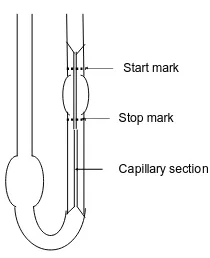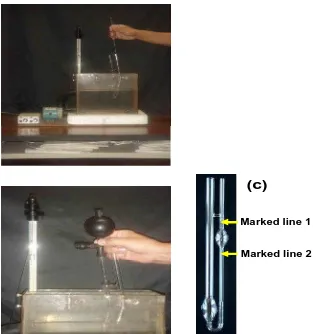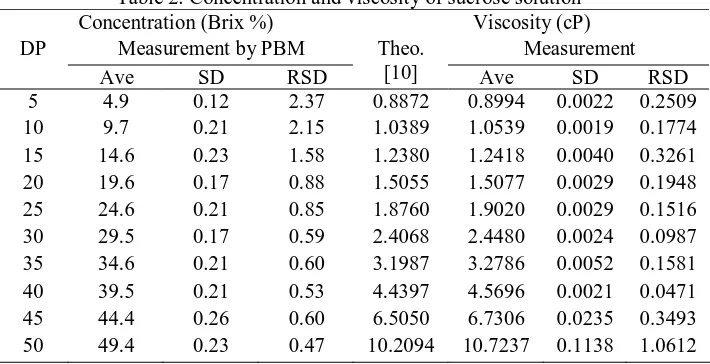MEASUREMENT OF VISCOSITY AND SUCROSE
CONCENTRATION IN AQUEOUS SOLUTION USING
PORTABLE BRIX METER
Eko Hidayanto1), 2), Teruo Tanabe2) and Jun Kawai2)
1) Departement of Physics, Diponegoro University, Semarang, Indonesia 2) Department of Materials Science and Engineering, Kyoto University, Japan
Abstract
The viscosity of aqueous sucrose solution in various concentrations and the sugar content were measured by using an Ostwald viscometer and a commercial available of portable Brix meter respectively. The increasing of the concentration of sucrose would also followed by increasing viscosity of the solution. Depending on their concentration, the measured value of viscosity of solution would be automatically confirmed into the desired concentration unit. The suitability of Brix meter for other application will be checked.
Keywords: viscosity, sucrose, Brix meter, solution concentration.
Abstrak
Viskositas larutan sukrosa air di berbagai konsentrasi dan kadar gula diukur dengan menggunakan viskometer Ostwald dan Brix meter portabel komersial. Hasil penelitian menunjukkan peningkatan konsentrasi sukrosa juga akan diikuti oleh peningkatan viskositas larutan. Nilai viskositas yang diukur bergantung pada konsentrasi larutan dan akan dikonfirmasikan secara otomatis ke dalam unit konsentrasi yang diinginkan. Kesesuaian meter Brix untuk aplikasi lainnya akan diperiksa.
Kata kunci: viskositas, sukrosa, Brix meter, konsentrasi larutan.
1. INTRODUCTION
Viscosity is a fundamental characteristic property of all liquid.
Viscosity of aqueous electrolyte
solutions is of considerable interest due to its importance in both natural and industrial processes. When a liquid flows, it has an internal resistance to
flow. The viscosity depends on
temperature, pressure and the type and composition of the material. The measurement of viscosity is significant
importance in both industry and
academia. Accurate knowledge of
viscosity is necessary for various
industrial processes. In industry,
viscosity allows distinguish directly the quality of the final product such as lubricating oils, fuels, inks, paints, and so on. Another importance of viscosity
in industry is to control the progress of
physicochemical reactions during
manufacturing. In the food processing, knowing the viscosity of the product is beneficial in that viscosity indicates consistency, pour-ability, concentration, and firmness to define product quality. In petroleum, all the range possibilities make the vibrating viscometers as efficient on light fuels as on bitumen [1].
The viscosity depends on
sucrose solution and its viscosity will be shown at the figure 1. The data of viscosity is taken from the references [3]. Increasing of concentration will influence on viscosity. From the
Figure 1. Viscosity of sucrose aqueous
solution at 300C [3].
There are several types of
viscometers classified into seven
categories by their measurement
principle as follows [4]: capillary, orifice, high temperature, rotational, falling-ball, vibrational, and ultrasonic
viscometer. The vibration-type
viscometer, the working principle is based on the vibration, either torsion, either translation, at resonance or controlled frequency of a module immerged in a liquid. The falling-ball viscometer, the working principle is based on measure of the time of the fell of a module placed in a vertical tube which contained a sample [1].
Capillary viscometer is most widely used for measuring viscosity. A common type of this capillary is called the “Ostwald” (shown at figure 2) with simple in operation, require a small volume of sample liquid, temperature control is simple and inexpensive. In
capillary viscometer, viscosity is
Capillary section Stop mark
Start mark
Figure 2. Ostwald viscometer
Refractive index of a medium or
a solution is a very important
characteristic parameter and some
associated parameters such as
temperature, concentration, viscosity, etc., may be estimated from it. Those parameters are used very often in
optical, chemical, and biomedical
industries. A simple and direct
measurement of reflectivity could
provide the refractive index of the test
medium by using only Fresnel’s
equation, it is related to the
measurement of light intensity variations [5]. The refractive index correlates closely to the molar fractions of the components in solution, and constant for a substance under standard conditions of temperature and pressure. The refractive index has been widely used to determine the concentration of sugar such as in food, fruit juices, etc. as the Brix Value (BV) [6-8].
The commercially available
The purpose of this study is to apply the suitability of this Brix meter to other portable viscometer by knowing
the relationship between the measured value of concentration and viscosity of
analyzed sample solution.
2. EXPERIMENTAL
The viscosity of sucrose was be determined by using Ostwald viscometer (Sougo Rikagaku Galasu Seisakusho, Kyoto, Japan). The distilled water obtained by Elix 5 is used for preparation of sucrose (C12H22O11 ; Nacalai Tesque, Inc Kyoto Japan; GR grade) standard solution. The viscosity is determined by measuring its rate of flow through a capillary tube. At a constant temperature of 303 K, the sucrose solution is added from the pipette to the Ostwald viscometer as illustrated at Figure 3(a). With the aid of a piece of rubber tubing or pipette filler, the liquid is sucked up the capillary arm of the viscometer until the surface of the liquid is above the upper mark as illustrated at Figure 3(b). The liquid is then allowed to flow down the arm. The time required for the surface of the liquid to pass from the upper mark to the lower mark is noted, as illustrated at
Then viscosity could be calculated using Poiseuille equation. The concentration of sucrose solution was measured by portable Brix meter of RA-250HE (Kyoto Electronics Manufacturing Co. Ltd.) by dropping the sample onto the prism, then pressing the read key and the result will appeared on the display, like as illustrated at figure 4. It can be calibrated with a drop of distilled water and cleaned by rinsing or wiping.
Marked line 1
Marked line 2
(a)
(b)
(c)
Figure 3. Measurement of viscosity of sucrose solution using Ostwald viscometer. (a) adding solution; (b) sucking up solution;
(c) measuring time
3. RESULTS AND DISCUSSION liquid to pass from the upper mark to the lower mark, the capillary constant is 4.1286 x 10-5 cm2/s2. The time required for sucrose solution is also noted, then its viscosity in various concentrations can be calculated and experimental value is compared to the reference.
measured values using portable Brix meter and the measured value of concentration of sucrose solution by portable Brix meter and by direct preparing is nearly similar, that describe at figure 5. It was seen at the figure 5 that there is relationship between the concentration and the viscosity. It was shown that increasing the concentration of sucrose solution gives rise to increasing viscosity. With this tendency, the value of solution viscosity can be predicted base on the read value of concentration on this portable Brix meter. So that, the Brix meter is
applicable to other uses than
concentration measurement
Table 2. Concentration and viscosity of sucrose solution*
Concentration (Brix %) Viscosity (cP)
Measurement by PBM Measurement
DP
0 10 20 30 40 50
Figure 5. Viscosity of sucrose solution in various concentrations at 303 K.
4. Conclusions
By using the easy and simply measurement of the viscosity of aqueous
sucrose solution in various
concentrations and the sugar content using an Ostwald viscometer and a commercial of portable Brix meter, the relationship between these parameters can be known. The experiment results
indicate that increasing of the
concentration of sucrose would followed by increasing viscosity. Depending on their concentration, the measured value of viscosity of solution would be automatically confirmed into the desired concentration unit. With this tendency, the value of solution viscosity can be predicted base on the read value of concentration on this portable Brix meter. So that, portable Brix meter is
[3] G. Roberto, “Calculations on Pure
Sucrose Solution,” 1997 on
Netherlands: Springer; p.1-14.
[5] C. Hsu, K. Chen, D. Su, Optics
Communications, 218 (2003), 205–211.
[6] Pomeranz Y, Meloan CE.

![Table 1. Brix measuring range for several samples [11]](https://thumb-ap.123doks.com/thumbv2/123dok/3749165.1817465/3.612.142.494.176.593/table-brix-measuring-range-samples.webp)


